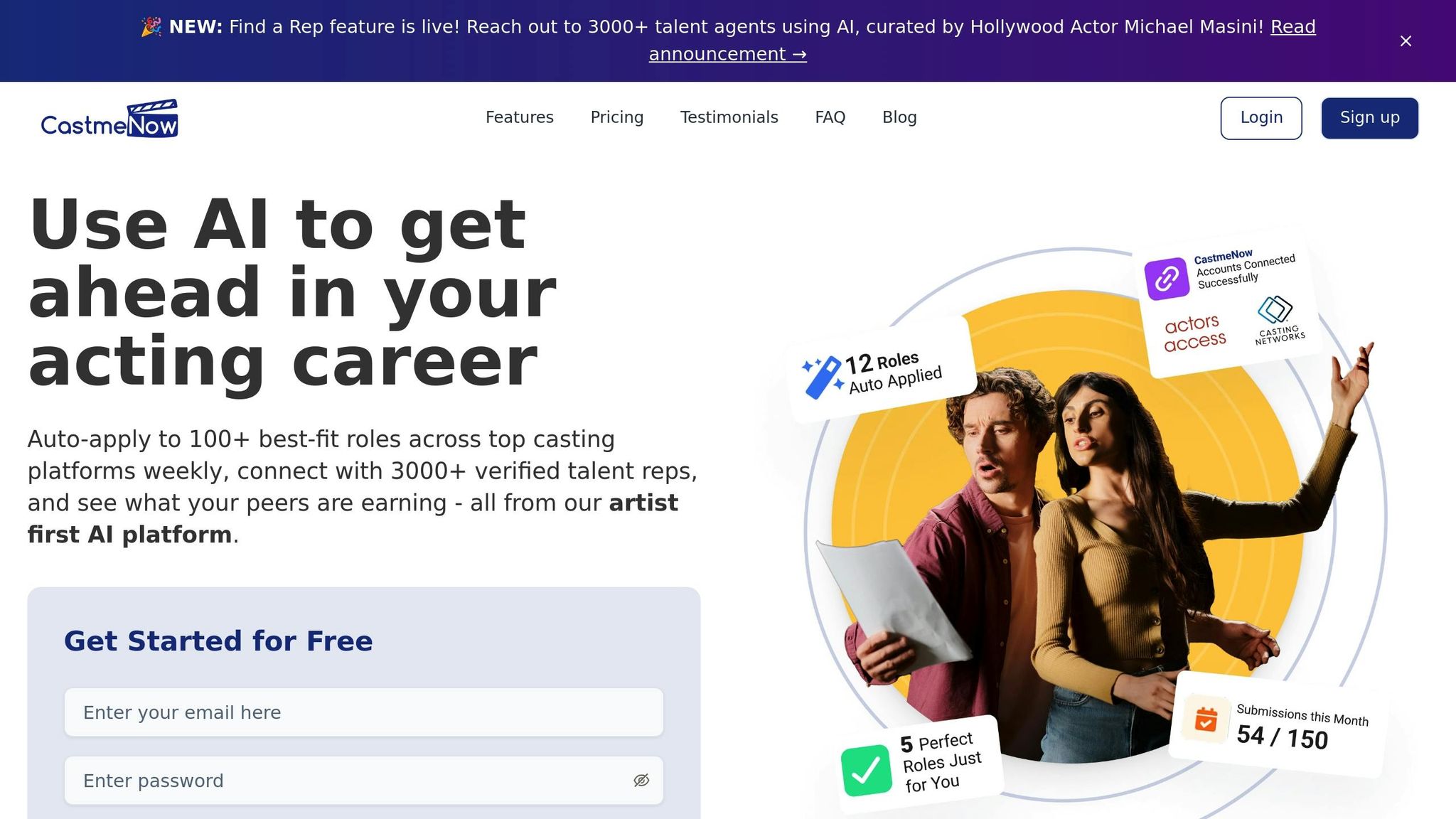Fixing Data Sync Failures: Step-by-Step Guide
Learn how to diagnose, fix, and prevent data sync failures to keep your casting profiles accurate and up-to-date.

Data sync failures can disrupt your workflow, leading to missed opportunities and errors. This guide simplifies the process of identifying, fixing, and preventing sync problems, ensuring your casting profiles stay accurate and up-to-date. Here's what you'll learn:
- Common signs of sync issues: Missing updates, duplicate entries, or error messages.
- How to diagnose problems: Check connection status, logs for error codes, and API limits.
- Fixing common issues: Resolve connection errors, data mismatches, and access problems.
- Preventing future failures: Regular system checks, monitoring tools, and standardized data practices.
Finding the Source of Data Sync Problems
Quickly diagnosing sync failures begins with a systematic check of common problem areas.
Signs Your Data Sync Is Failing
Spotting sync issues early can help you avoid missed opportunities and unnecessary headaches. One clear sign is incomplete data transfers between profiles - like when profile updates don't reflect consistently across platforms. You might also encounter a "Synchronization failure" message in your dashboard.
Another warning sign is the need to manually update information across multiple platforms. If you're frequently double-checking whether profile changes have synced or dealing with unexpected callbacks for roles, your sync process is likely malfunctioning. Other operational inefficiencies, such as delays in seeing new role matches or inconsistent application responses, can also signal trouble.
Once you notice these signs, it's time to dig deeper to find the root cause.
Steps to Identify the Problem
Diagnosing sync problems requires a step-by-step approach. Start by reviewing your connection status in the CastmeNow dashboard. Look for red indicators or warning messages tied to your Casting Networks or Actors Access connections.
Next, check your sync logs for error codes, which can reveal issues like authentication failures due to expired or updated login credentials. These logs are invaluable for identifying configuration mismatches or data conflicts.
Monitor API usage to ensure you haven’t hit any limits. Some casting platforms cap how often automated tools can access their systems, temporarily halting syncs until the limits reset.
Verify your data mapping configurations to confirm that profile fields are correctly aligned. Also, ensure your network is stable and that security settings allow CastmeNow to access the necessary data fields for synchronization. If any fields are restricted, the integration user may not have the required permissions to complete the sync.
After completing these checks, diagnostic tools can help pinpoint more specific issues.
Tools That Help Find Sync Issues
Specialized tools can simplify troubleshooting by providing real-time insights into sync performance. Continuous monitoring, for example, has been shown to reduce data error resolution time by 45%, enabling quicker fixes and fewer disruptions.
CastmeNow’s built-in logging system offers detailed insights into sync attempts. These logs show when connections are made, what data is transferred, and where failures occur, helping you quickly identify the source of the problem.
Understanding common failure patterns can also streamline the diagnosis process. Studies reveal that 30% of integration issues are caused by authentication errors, while 40% are linked to unresponsive webhooks.
Here’s a quick breakdown of common issues, their impact, and suggested solutions:
| Issue Type | Impact Percentage | Recommended Action |
|---|---|---|
| API Key Issues | 30% | Verify and recreate keys as needed |
| Data Mapping Errors | 25% | Regularly audit mappings |
| Network Connectivity Problems | 15% | Use monitoring tools |
| Version Mismatches | 20% | Schedule regular updates |
To keep your sync running smoothly, verify API keys and permissions to ensure data flows accurately between platforms. Regular audits of your data mapping configurations can help minimize errors. Additionally, real-time network monitoring tools can quickly identify and resolve connectivity issues.
With the right tools and a clear understanding of what to look for, automation can cut testing time by as much as 40%, making it easier to resolve problems and keep your operations running efficiently.
How to Fix Data Sync Failures
When a data sync failure occurs, the key to resolving it is identifying the root cause and addressing it with targeted solutions. Different problems require tailored approaches to get systems back in sync.
Fixing Connection Problems
Start by checking your credentials - usernames, passwords, and app tokens - especially if they’ve been updated recently. If you encounter an HTTP/1.1 403 Forbidden error, double-check your credentials and app token, then retry the sync job.
Use the ping command to test connectivity. If you encounter timeouts, it’s time to contact your IT team to review firewall settings between the sync agent and the file server.
Ensure the CastmeNow sync agent has access to Casting Networks and Actors Access. If the agent stops functioning, restart it, and if there have been schema changes, recreate the sync group.
To handle temporary network interruptions, implement retry logic in your sync processes. This small adjustment can prevent minor network glitches from causing complete sync failures, saving time and reducing the need for manual fixes.
Fixing Data Field and Quality Issues
Once connection issues are resolved, focus on data field mismatches that could disrupt synchronization. To avoid problems like inconsistent field names or mismatched data types, document everything - field names, data types, transformation rules, and how null values are handled.
Data quality issues can have a serious financial impact. A 2022 survey revealed that poor data quality led to a 10% loss in annual revenue for many businesses. To combat this, create a data tracking plan that standardizes how information flows between your casting profiles and CastmeNow. This helps ensure consistency and minimizes mapping errors.
Before deploying changes to production, test all field mappings in a sandbox environment. Treat these configurations like code - use version control and change management practices to avoid unexpected issues when casting platforms update their data structures.
Add validation and transformation layers to your sync processes to keep data clean and consistent before it reaches target systems. Real-time monitoring tools and anomaly detection can also help catch field-related issues before they escalate into sync failures.
Fixing Access and Security Problems
After ensuring clean data and proper mappings, turn your attention to access and security settings that might block synchronization. A thorough review of these configurations is essential.
If you see a "Failed to retrieve agent activation key" error, it could mean network security settings are blocking the sync agent connection. For VPC service endpoints, verify that your security group settings allow the agent to connect. If you’re using public endpoints, check your firewall and router configurations to ensure connectivity. These issues are common but can usually be resolved with proper setup.
Check that your account has the necessary permissions for sync operations. Missing permissions, such as "syncGroupOperationResults/read", can cause authorization errors and stop data from flowing between systems.
For systems using Kerberos authentication, ensure your SMB file server is specified as a domain name rather than an IP address. Double-check that authentication principals match exactly and that passwords haven’t changed since the key files were created. Also, confirm that the Kerberos configuration file contains the correct realm information and that TCP port 88 (used by the Key Distribution Center) is open.
Finally, grant comprehensive permissions to your sync processes. This includes read access to sync member operations, agent operations, and group operations. Without these permissions, your automated casting applications may not have the access they need to function properly.
How to Prevent Future Sync Problems
Keeping your systems in sync is all about routine care and smart practices. With a little effort upfront, you can avoid frustrating sync failures, save time, and ensure everything runs as it should.
Regular System Checks and Updates
Make it a habit to review your casting profile data, like headshots, resumes, and contact details, across all platforms. Outdated information can lead to sync issues, so clearing out old data is key.
Using monitoring tools can also be a game-changer. These tools can alert you to sync discrepancies as they happen, giving you the chance to fix problems before they grow . Real-time alerts and monitoring systems are especially helpful for spotting and addressing issues quickly.
Don’t forget to keep your systems up to date. This includes both your casting profile accounts and any profile management software you use. Updates often bring improvements and bug fixes that make syncing easier. Also, standardize your casting data - use consistent naming conventions and file formats to ensure smooth integration.
Pair these regular checks with detailed documentation to build a reliable sync maintenance plan.
Recording and Testing Your Settings
Documenting your setup can save you a lot of headaches. Keep a record of your CastmeNow configuration settings, such as role preferences, geographic filters, and custom options. According to Traceable, teams that prioritize documentation cut onboarding times by 50%.
Before making changes to your CastmeNow settings, test them in a controlled environment. Automated testing can reduce errors by 90% compared to manual methods. This is especially important when updating casting preferences or adding new platforms to your sync setup.
Run simulation tests to see how your system performs under different conditions. For instance, test how your sync handles heavy usage. Companies that use continuous monitoring report a 45% faster resolution of data errors, and those that run simulations before major updates experience 25% fewer issues afterward.
Create feedback loops during your testing process. By analyzing results at each step, you can refine your approach and adjust settings to prevent future problems.
Maintaining Good Network Connections
A strong and stable network is the backbone of any sync process. To keep things running smoothly, optimize your network setup:
- Place your router centrally and off the ground to limit interference.
- Keep router firmware and network adapter drivers up to date.
- Use devices that support the latest wireless frequencies.
Dynamic routing protocols can also help by reducing network congestion - sometimes by as much as 25%. This ensures smoother communication between CastmeNow and casting platforms.
"Network routing is key because it makes sure data moves well between devices and places... It also helps with big networks, making them fast, reliable, and stable." - Jerry Sheehan, SynchroNet CEO
Timing matters too. Schedule your most critical sync tasks during off-peak hours when your network is less busy. With poor data quality costing U.S. organizations about $3.1 trillion annually, reducing network-related sync failures is a must.
You might also want to consider bandwidth throttling. By limiting how much of your internet connection CastmeNow uses during sync operations, you can prevent it from hogging resources and ensure other applications continue to run smoothly.
CastmeNow Sync Issues and Solutions

CastmeNow offers a range of tools to help identify and resolve sync issues, making it easier to troubleshoot and keep your automation tasks running smoothly.
Checking Your Casting Profile Connections
A stable connection to casting platforms is essential - without it, automation stops, and opportunities can slip through the cracks.
Start by verifying your profile credentials and permission settings. Platform updates often require re-authorization, so head to your CastmeNow dashboard and check for connection status indicators. If you see red or warning symbols next to linked profiles, it’s a sign that something needs attention.
Double-check that CastmeNow still has the permissions it needs to access your profile data, submit applications, and update information across platforms. If issues persist, dive into the automation logs for error codes that can provide more details.
Using CastmeNow Logs to Find Errors
If your connections seem fine, the next step is to dig into the logs. CastmeNow’s automation logs track every action the platform performs, from successful applications to failed attempts, and they include error messages that highlight what went wrong.
To access the logs, open your dashboard and look for entries marked with error codes or failure notifications. These logs will show you which casting opportunities encountered problems and the exact errors that occurred. Common issues include authentication problems, missing profile information, or network timeouts.
Pay attention to any patterns in the errors, such as specific times or types of roles where issues arise. If the problems are tied to a particular casting platform, it might point to platform-specific challenges or settings that need adjustment.
Getting Help from CastmeNow Support
If the built-in tools don’t resolve the problem, CastmeNow’s support team is ready to help. They have access to more detailed system logs and can uncover issues that might not appear in your dashboard.
Before reaching out, gather as much information as possible. This includes error logs, timestamps, affected platforms, and any recent changes you’ve made to your profile or settings. Providing these details will help the support team diagnose the issue faster.
If you’re still in the free 30-day trial, take advantage of it to test different configurations and work with support to fine-tune your setup. This trial gives you full access to all features without needing to enter payment details, making it an ideal time to address recurring errors.
The support team can also recommend ways to improve your sync settings for greater reliability. They might suggest configuration tweaks, alternative methods for role matching, or identify platform-specific updates that could be causing issues. Since CastmeNow acts as an automation layer on top of casting platforms, their insights can be invaluable for understanding how platform changes impact your sync performance.
Lastly, keep a record of the solutions provided by support. Sync issues can resurface, especially when casting platforms update their systems, so having a reference can save time if similar problems occur in the future.
Conclusion: Keeping Your Data Sync Working
Data sync problems can throw a wrench in your casting workflow, but with the right strategies, you can maintain steady connections and keep opportunities within reach. The trick lies in blending regular upkeep with quick troubleshooting whenever issues pop up.
Staying on top of things through consistent monitoring is crucial. Poor data quality can seriously disrupt operations, and for actors using automated tools, even minor sync errors might lead to missed auditions or lost chances.
Beyond monitoring, having clear documentation and conducting regular tests can act as a safety net. The best strategy combines automated tracking with manual checks. Set up alerts to flag connection failures, authentication issues, or system bottlenecks. Real-time monitoring tools can help you keep an eye on system performance, so you can address problems as soon as they arise.
A stable internet connection is another cornerstone of reliable syncing. Make sure your network is consistent, and consider having a backup option in case your primary connection becomes unreliable.
Using CastmeNow’s automation tools can further streamline your sync maintenance. While CastmeNow simplifies many technical hurdles, understanding how syncing works equips you to handle any hiccups more effectively. Pairing these automated tools with proactive practices creates a system that stays resilient, even as casting platforms evolve.
Finally, remember that sync issues often crop up when platforms update their systems. Keep detailed records of past solutions so you can quickly address recurring problems. This ensures your casting automation stays reliable and that you never miss a beat when opportunities arise.
FAQs
What are the best tools for monitoring and troubleshooting data sync issues in real-time?
To keep a close eye on data synchronization and address issues as they happen, tools like Prometheus, Grafana, Datadog, and Pingdom can be incredibly helpful. These platforms offer in-depth performance insights, allowing you to pinpoint and fix synchronization failures quickly.
With these tools, you can monitor key metrics, create alerts, and visualize data flows, making the entire sync process more streamlined and effective. Whether you're managing automated workflows or handling intricate integrations, using the right monitoring tools is crucial for ensuring data remains accurate and dependable.
How can I keep my data mapping configurations accurate to avoid sync issues?
To keep your data syncing smoothly, it's important to review your data mapping settings on a regular basis - especially after making any changes to data sources or structures. Automating updates wherever you can is a smart move, as it cuts down on manual errors and saves time.
You should also implement validation checks to verify data accuracy and keep an eye on synchronization logs. These logs can help you spot and resolve any issues quickly. Taking these proactive steps ensures your data syncs remain efficient and reliable.
How can I secure my network and avoid interruptions in data synchronization?
To keep your network secure and ensure smooth data synchronization, here are some practical steps you can take:
- Turn on encryption for data, whether it’s moving across the network or stored, to safeguard sensitive information.
- Change default passwords and replace them with strong, unique ones for every device.
- Restrict access by granting permissions only to users who truly need them.
- Regularly update your software and tools to fix security gaps and improve functionality.
- Set up firewalls and intrusion detection systems to block unauthorized access attempts.
- Physically protect your network equipment to prevent tampering or theft.
On top of these measures, keep a close eye on your network's performance and use reliable hardware to reduce the risk of interruptions. Periodic risk assessments are also a smart way to spot and address potential problems before they grow into bigger challenges.

